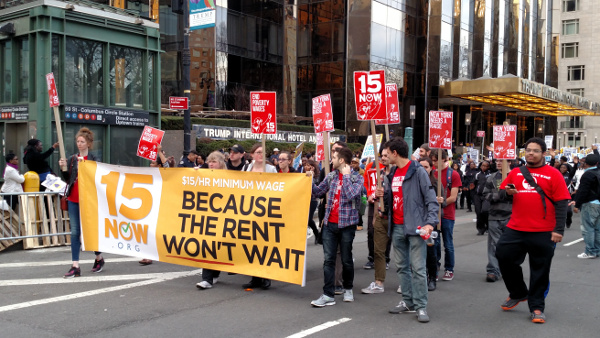
PHOTO/THE ALL NIGHT IMAGES
Editors note. This article is excerpted from a longer version published in the Tribuno del Pueblo.
CHICAGO, IL — On April 15, 2015, fast-food workers held rallies in 236 U.S. cities in their biggest protest yet for higher pay and union rights. In addition, tens of thousands of people from 40 countries across the globe came together for fair wages and the right to organize and as a part of the Fight for 15.
The Fight for 15 arose on the heels of the Occupy Wall Street movement of 2011. But, it had been stewing since the 1980s, when government and corporations united in their attack on the workers and their unions by demanding concessions. Though the corporations won the concessions struggles, in the 1990s, a new force entered the struggle. Low wage workers led massive demonstrations of janitors. This resulted in tens of thousands of workers joining unions.
The massive recession, beginning around 2001 led to huge demonstrations over immigrant rights that were not only about “documents,” but about earning decent wages and rights on the job, schools and in communities. Then, the great depression of December 2007, which worsened in 2008, spread around the world. Home foreclosures and job loss exploded while opportunity and hope disappeared across the country.
The wave after wave of shocks caused by an increasingly worsening economic crisis called forth both opposition and various individuals and organizations who attempted to represent today’s burgeoning movement. We are the 99%. Profound. A demand to raise the minimum wage could not be contained. In Illinois, the minimum wage raise struggle began in 2006 and increased over the following two years. In California, Massachusetts, Maine and Maryland, legislatures introduced bills to increase their state minimum wages. This movement influenced the 2008 elections of “Hope and Change.”
Fight for 15 congealed a vast movement for low-wage workers, and has given life to other workers not in “low wage” sectors. It has generated a movement of workers and created a more broadly renewed class awareness not seen in the U.S. in some time. Its demands include not only a fair wage, but raises questions over health care, jobs, housing and education, what should be a standard of living for the U.S. and world.
Unfortunately, organizations behind the leadership and direction of the Fight for 15 have their own separate goals. One is to control this massive movement within corporate needs in spite of the many well-intentioned forces around this movement. Some would prefer to impel the movement into the arms of the Democratic Party with its limited goals and limited desire for transformational change.
The 99% need strategy, vision and organization to distribute ideas class-wide. These are essential tools in fighting for control of the direction of our country and a new stability in a new economic system that can meet our needs today.
Fight for 15 and Occupy: waves in a continuing struggle
Latest
The People’s Tribune opens its pages to voices of the movement for change. Our articles are written by individuals or organizations, along with our own reporting. Bylined articles reflect the views of the authors. Articles entitled “From the Editors” reflect the views of the editorial board. Please credit the source when sharing: peoplestribune.org. Please donate to help us keep bringing you voices of the movement for change. Click here. We’re all volunteer, no paid staff. The People’s Tribune is a 501C4 organization.

